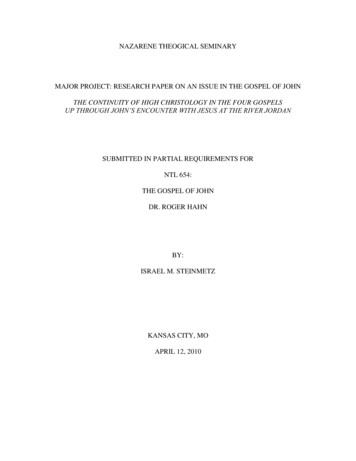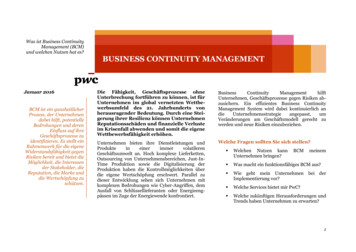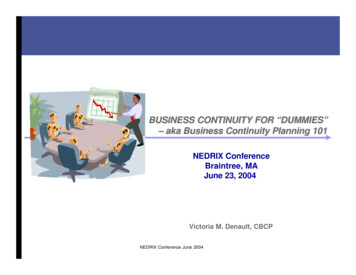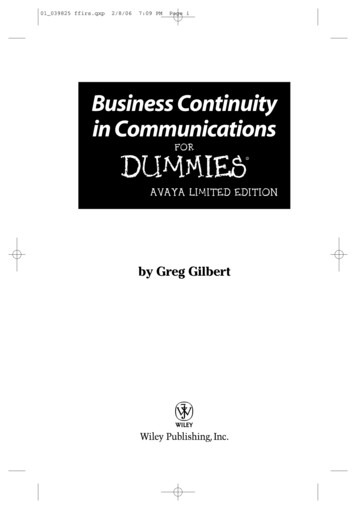
Transcription
NAZARENE THEOGICAL SEMINARYMAJOR PROJECT: RESEARCH PAPER ON AN ISSUE IN THE GOSPEL OF JOHNTHE CONTINUITY OF HIGH CHRISTOLOGY IN THE FOUR GOSPELSUP THROUGH JOHN’S ENCOUNTER WITH JESUS AT THE RIVER JORDANSUBMITTED IN PARTIAL REQUIREMENTS FORNTL 654:THE GOSPEL OF JOHNDR. ROGER HAHNBY:ISRAEL M. STEINMETZKANSAS CITY, MOAPRIL 12, 2010
CONTENTSIntroduction2Purpose & raphy301
IntroductionFrom its declaration that “the Word was God”1 to Thomas’ worship of Jesus as“My Lord and my God!”2 John’s gospel proclaims a majestically high Christology.3Indeed, some have seen in John a Christology that finds no parallel in the SynopticGospels.4 For them, John’s logos5 and incarnational6 thought and his explicit portrayal ofJesus’ divinity is juxtaposed with the less exalted portraits of Jesus in the Synoptics. 7 Toput it simply, “If Jesus was as He is depicted in Matthew and Mark and Luke, He cannothave been as He is depicted in John. The two are incompatible.”8But is this contrast between John and the Synoptics accurate? Does it give a fairreading to the Christological titles and roles assigned to Jesus by the other evangelists? Itis our position that such a view fails to account for the Christological motifs developed inthe Synoptics9. Further, by doing so it creates a false dichotomy between John and theother evangelists on the point of exalted Christology.1John 1:1. Unless otherwise noted all Scripture taken from the New American Standard Bible.John 20:28.3For a summary of Johannine Christology followed by an extensive bibliography see Paul N. Anderson,The Christology of the Fourth Gospel: its unity and disunity in the light of John 6, WissenschaftlicheUntersuchungen zum Neuen Testament, 2, Reihe, Herausgegeben von Martin Hengel und Otfried Hofius,78, (Tubingen, Germany: J.C.B. Mohr (Paul Siebeck), 1996), 266. See also Craig S. Keener, The Gospel ofJohn: A Commentary, Volume I, (Peabody, MS: Hendrickson Publishers, 2003), 280-320.4See e.g. Raymond E. Brown, The Birth of the Messiah: A Commentary on the Infancy Narratives in theGospels of Luke and Matthew, New Updated Edition, The Anchor Bible Reference Library (New York:Doubleday, 1993), 29-32.5A.E. Harvey, A Companion to the New Testament, Second Edition (Cambridge: CambridgeUniversity Press, 2004), 290-292.6John Macquarrie, “Incarnation,” in The Blackwell Encyclopedia of Modern Christian Thought, ed.Alister E. McGrath (Oxford: Blackwell Publishers, 1995), 269-270.7Cf. D.A. Carson, “The Johannine Writings,” in New Dictionary of Biblical Theology, ed. T.Desmond Alexander, et al (Leicester, England: Inter-Varsity Press, 2000), 133.8Leon Morris, The Gospel According to John, New International Commentary on the NewTestament, Gen. Ed. F.F. Bruce (Grand Rapids: Eerdman’s, 1971), 45. Morris states the maxim though hedisagrees with it.9For a summary of Synoptic Christology see D.A. Hagner, “Synoptic Gospels,” in NDBT, 128-129. For anextended treatment see Raymond E. Brown, An Introduction to New Testament Christology (Mahwah, NJ:Paulist Press, 1994).22
Scope & PurposeIt is outside the scope of this paper to survey all of the Christological motifs10 inthe gospels, so we limit ourselves to the depiction of Jesus in the opening scenes of each.While all four evangelists approach Jesus’ coming into the world from a uniqueperspective, they all connect his entry into human history with the ministry of John theBaptist, culminating in their encounter at the Jordan. We will restrict ourselves to theseopening scenes11 and demonstrate that in all four gospels the evangelists magnificentlydeclare Jesus’ identity. Thus, exalted Christology emerges as a unifying theme betweenthe Gospels’ introduction of Jesus, rather than a point of discontinuity.Given our scope we will mostly neglect various questions in the text includingauthorship, audience, historicity, textual variants, and the Synoptic Problem.12 These,and other issues, will only be considered when they directly impact the question, “Do theSynoptics as we currently have them present Jesus in the highest Christological termsfrom the outset or is this a unique feature of John’s Gospel?” In order to answer thisquestion we will survey the gospels in the order in which they were likely written13 andconclude with an integration of our findings.MarkDespite the importance of the “messianic secret” for the players in Mark’s gospelhis concern for the audience is that they recognize Jesus as the Christ, the Son of God.This is clear from his opening lines, “The beginning of the gospel of Jesus Christ, the Son“Motif” is preferable to “title” given the inadequacy of titles to provide a complete picture ofChristology. For a brief discussion of the issue see R.T. France, Matthew: Evangelist & Teacher, NewTestament Profiles (Downer’s Grove, IL: InterVarsity Press, 1989), 280-281.11Matt 1:1-3:17, Mark 1:1-11, Luke 1:1-3:22, John 1:1-34.12Discussions of each of these issues can be found in the commentaries in our Bibliography.13For a defense of the chronology used in this paper (Mark-Matthew-Luke-John) see Raymond E. Brown,Introduction to the New Testament, The Anchor Bible Reference Library (New York: Doubleday, 1997)164, 217, 274, 368-371.103
of God,”14 to Peter’s confession, “You are the Christ,”15 to the declaration of thecenturion at the cross, “Truly this man was the Son of God!”16 As an evangelist, Mark isconcerned with relating the life of Jesus of Nazareth; as a theologian, he identifies Jesuspositively as “Lord of the Church and Son of God”.17 His focus at the outset is on histask as theologian, and in highly exalted terms he thrusts Jesus into human history. Markis not concerned with Jesus’ birth, youth, or family background but commences with amajestic title and the Baptist’s preparatory ministry. 18The beginning Mark makes careful use of the few words of his gospel, filling them withtheological import. His title, “The beginning of the gospel of Jesus Christ, the Son ofGod,”19 is no exception. Lohmeyer believes Mark harks back to Genesis by opening hisgospel with “Beginning” arche.20 Such a phrase arrests our attention, suggesting that anew era has dawned. This new era promises “good news” euanggelion that ushers in a“new situation for the world.”21Jesus ChristThe good news is about “Jesus Christ”, a name and title pregnant with meaning.Unlike the other evangelists Mark does not explicitly connect Jesus’ ministry with the14Mark 1:1.Mark 8:29.16Mark 15:39. C.f. Ralph P. Martin, Mark: Evangelist and Theologian (Grand Rapids, MI: ZondervanPublishing House, 1972), 126.17Ibid., 139.18In this he resembles John but differs from Matthew and Luke. See Donald H. Juel, The Gospel of Mark,Interpreting Biblical Texts, Gen. Ed. Charles B. Cousar (Nashville: Abingdon Press, 1999), 93.19Mark 1:1.20E. Lohmeyer, Kommentar, 10, as quoted in Martin, 127. In this way Mark resembles John (1:1- “In thebeginning”- en arche) over Matthew (1:1- “record”- biblos) and Luke (1:1- “account”- diegesin).However, Brown (Birth, 140) sees Genesis motifs in Matthew’s gospel as well.21William L. Lane, The Gospel According to Mark, New International Commentary on the NewTestament, Vol 2, Gen ed. F.F. Bruce (Grand Rapids: Eerdman’s Publishing Company, 1974), 43.154
removal of sins22 at this early point in his gospel23 however, we should not miss theimplicit reference given in Jesus’ name itself24 which means, literally, “Yahweh issalvation.”25 In itself the name is not necessarily significant26 however in the light ofJewish history and the remainder of what is revealed throughout Mark the reader can hearin the name of Jesus echoes of Matthew 1:21, “He will save His people from their sins.”Christ/Messiah means literally “anointed one” and should be understood here as adesignation referring to a coming king, anointed by God, from the house of David.27Jewish expectation of a coming Messiah in Jesus’ time was prevalent.28 While the OTmentioned many “anointed ones”29 an evolution in Jewish expectation had occurredduring the inter-testamental period and by Jesus’ time the messianic hope for many hadcoalesced around a single kingly figure, anointed by God to rescue His people.30 Mark’sclaim should be understood in these exclusive terms. Jesus is the Messiah.Son of GodTo this point Mark has introduced Jesus in exalted terms that could stand alone, asthey do in some manuscripts. However, others complete the title with, “the Son of God”.Given textual and contextual considerations we opt for the view that “Son of God” should22C.f. Matt 1:21, Luke 1:77; 2:11, 30, John 1:29.Mark will make this connection explicit soon (Mark 2:1-12).24Jesus Iesou is a Hellenized form of the Hebrew Joshua and Aramaic Jeshua.25This owes not only to its etymology, but its common usage among the Jewish people at Jesus’ time. SeeR.A. Cole, The Gospel According to St. Mark, The Tyndale New Testament Commentaries, Gen. Ed.R.V.G. Tasker (Grand Rapids, MI: Wm. B. Eerdman’s Publishing Company, 1961), 55.26The name Jeshua/Joshua was common in the OT (c.f. 1 Sam 6:14, 1 Chr 24:11, 2 Chr 31:15, 2 Kings23:8, Ezra 2:2, et al) and there is at least one other “Jesus” named in the NT (Acts 13:6).27Mark uses it in titular form to declare the identity of the one whose life became good news. For adiscussion of Mark’s titular Christology see Edwin K. Broadhead, Naming Jesus: Titular Christology in theGospel of Mark, Journal for the Study of the New Testament Supplement Series, 175, Exe. Ed. Stanley E.Porter (Sheffield, England: Sheffield Academic Press, 1999).28Though it was by no means universal or universally understood and is perhaps overstated at times today.Cf. Juel, 99-103.29E.g. kings, priests, etc.30Juel, 101-103.235
be retained as integral to the opening lines of the gospel31 that serve—not only as a title—but as a summary of its content.32Juel asserts that Mark gives us his most explicit identification of Jesus in thistitle.33 Jesus is the Messiah, but He is more. He is the Messiah who is uniquely the Sonof God. Lohmeyer summarizes the implications of Jesus’ divine Sonship for Mark, “TheSon of God is not primarily a human but a divine figure He is not merely endowed withthe power of God, but is himself divine as to his nature; not only are his word and hiswork divine, but his essence also.”34 Lohmeyer’s claim captures the essence of what iscommunicated about Jesus as “Son of God” throughout the gospel.35The wilderness messengerWe will speak more of the Baptist’s ministry in our treatment of the other gospels,suffice to say that in Mark’s mind John bears the mantle of Isaiah in preparing the way ofthe LORD.36 John’s proclamation “announces the coming of the Messiah who introducesthe new age of redemption promised through the prophets.”37 To put it simply, Johnmust “make a road for God.”38 In the OT the way was prepared for “the LORD”39, hereJohn is preparing the way for the One would come to be known as Lord40 of the church.4131Following Cole (55), Lane (41), Martin (126-127) and others. For a discussion of the textual issues seeC.E.B. Cranfield, The Gospel According to St. Mark, The Cambridge Greek Testament (Cambridge:Cambridge University Press, 1963), 38.32Cole, 55.33Juel, 92.34E. Lohmeyer, Kommentar, 10, quoted in Martin, Mark, 127, cf. Lane, Mark, 44.35C.f. Mark 1:11, 3:11, 8:38, 9:7, 12:6, 13:32, 14:36; 61, 15:39.36For a discussion of Isaiah themes throughout the gospel of Mark see Sharyn Dowd, Reading Mark: ALiterary and Theological Commentary on the Second Gospel (Macon, GA: Smith & Helwys, 2000).37Lane, 45.38Cole, 57.39Hebrew Yahweh, Gk. LXX kurios.40Gk. kurios41Lane, 46.6
John’s appearance in Israel as a prophet was a spectacular event, breaking nearlyfour hundred years of God’s prophetic silence. Yet his task—vital and urgent as it was—was infinitely less valuable than the One he preceded.42 This One is mightier andperforms an infinitely superior baptism.43 John places himself in drastic juxtaposition tothis One by stating his unworthiness to loose His sandals.44Encounter at the JordanBy the time Jesus arrives at the Jordan He has been proclaimed by the evangelistas Messiah, the Son of God, and by John as the mighty baptizer in the Holy Spirit, thedivine emissary for whom God has sent John to prepare the way. In order to climax thisopening scene One above the evangelist and the Baptist must speak.45 As Jesus comes upout of the waters of baptism the heavens are torn apart and the Spirit of God descends asa dove.46 God’s voice47 is heard from heaven speaking to Jesus, “You are my belovedSon, in You I am well-pleased.”48The address from heaven is drawn from several OT texts49 and is intended tocommunicate not only Jesus’ identity as the promised Davidic Messiah/king, but thespecial relationship between Father and Son.50 “Beloved Son”, a present indicative,expresses “an eternal and essential relationship” while the aorist indicative, “in whom I42Cole, 58.Mark 1:7-8.44Lane, 52.45Ibid., 58.46C.f. Isaiah 64:1. For a discussion of the significance of the dove in this passage see Martin, 127.47Many scholars suggest this should be understood as the bath qol, Hebrew for “daughter of the voice”,understood as an “echo” of God’s voice (see e.g. Martin, 105).48Mark 1:11. The sight of the dove and the sound of the voice strengthen the theophany (Dowd, 11).49Psalm 2:7, Isaiah 42:1, and probably Genesis 22:2.50Martin, 105. Cf. Lane, 58. The unique character of the relationship is strengthened if we follow Cole(58), and Lane (58) in detecting a connotation of “only” in the phrase “beloved” (cf. Gen 22:2). ContraJuel (91) who suggests that “Son” should be understood primarily as a royal/messianic title.437
am well pleased” refers to God’s pleasure in Jesus’ current actions. 51 Thus we shouldinterpret “Beloved Son” in “the highest sense, transcending messiahship.”52 Understoodagainst their Hebraic background the events at the baptism are intended to convey to thereader Jesus’ supernatural origin.53SummaryThe climax of Mark’s introduction of Jesus reminds us of his opening words, thisis “the gospel of Jesus the Christ, the Son of God.” Mark’s Christology, while clearlyexalted, is also implicitly incarnational. Jesus is a man—from Nazareth in Galilee of allplaces!—and yet He is the Beloved Son of God. In short order Jesus will heal the sickand cast out demons,54 forgive sins,55 claim Lordship over the Sabbath,56 control nature,57receive worship,58 feed multitudes,59 walk on water,60 and rise from the dead.61 Jesusdoes that which only God has the power and authority to do and receives the titles andaccolades that God alone deserves.MatthewLuz is correct that, “Matthew’s Christology is more than a semantic fieldstructured by titles Rather it is the story of a human being in whom God is and was‘with us’.”62 Thus we will consider the broad motifs related to Jesus as they occur in the51Lane, 58.Ibid., 57.53Martin, 128.54Mark 1:32-34.55Mark 2:5.56Mark 2:28.57Mark 4:35-41.58Mark 5:6.59Mark 6:30-44.60Mark 6:45-5261Mark 16:6.62Ulrich Luz, Studies in Matthew, trans. Rosemary Selle (Grand Rapids, MI, William B. Eerdman’sPublishing Company, 2005), 96. C.f. discussion of Christology and titles in France, 280—281.528
opening scenes of Matthew’s narrative in order to sketch a portrait of the evangelists’Christological concerns.The record Matthew begins, “The record of the genealogy of Jesus the Messiah,63 the Son ofDavid, the Son of Abraham.”64 That Messiah should be understood as referring to the“Messianic King” of Jewish expectation seems clear.65 That it is equivalent to “Son ofDavid” in the author’s mind is also likely.66 However Messiah should not be understoodstrictly as a title, but in the broader context of what the gospel reveals about Jesus. For inMatthew Jesus ultimately exceeds all that the Jews expected of the Messiah. The title,while accurate, is thus inadequate.67 Its full meaning must be derived from the remainderof what is said about Jesus.68Son of David“Son of David” has a greater prominence in Matthew than in the remainder of theNT.69 But what does the title convey? To be sure the Son of David is the Messiah andthe rightful heir to David’s throne.70 However, Luz argues that the tradition history ofNRSV, NASB have “the Messiah” while NIV, NKJV have “Christ”. The Greek is Christou with noarticle supplied. The title “Christ/Messiah” occurs with the definite article just seven times in theSynoptics, six of them in Matthew. When used in reference to Jesus the title should be understood as “anembodiment of the faith of the early church,” Brian M. Nolan, The Royal Son of God: The Christology ofMatthew 1—2 in the Setting of the Gospel, Orbis Biblicus Et Orientalis, 23 (Fribourg, Switzerland: EditionsUniversitaires Fribourg Suisse, 1979), 116. Brown understands “Jesus Christ” (Matt 1:1, 1:18) to be almosta proper name, derived from the devolution of “Jesus the Messiah” to “Jesus the Christ” to “Jesus Christ”in early Christian usage (Birth, 59).64Matthew 1:1.65Craig S. Keener, Matthew, The IVP New Testament Commentary Series, ed. Grant R. Osborne,(Downer’s Grove, IL: InterVarsity Press, 1997), 52.66Nolan, 149.67Brown, Birth, 135-136.68So France, 282-283, who suggests that the Messianic secret for Matthew owes to the fact that Matthewwanted his audience to see Jesus as Messiah, but not strictly according to their Messianic expectations.69Matthew uses the term 10 times (more than the remainder of the NT combined), Mark and Luke only 4,John does not utilize it (Brown, Birth, 134). Seven of his usages are unique to Matthew (France, 284).70Keener, Matthew, 52. See also France, 286 and Daniel J. Harrington, The Gospel of Matthew, SacraPagina Series, Volume 1, ed. Daniel J. Harrington (Collegeville, MN: The Liturgical Press, 1991), 32.639
the phrase is insufficient to establish its meaning for Matthew. Rather, Matthew utilizesthe phrase to make a connection with his audience, before pushing them to a muchgreater understanding of the term.71The genealogyThat Matthew’s genealogy is highly selective and serves a deliberate theologicalpurpose is obvious.72 Hebrew genealogies were generally given in order to demonstrateidentity via tribal origins, under gird one’s official status (e.g. kings, priests), orunderscore a collective personality.73 Matthew utilizes Jesus’ genealogy74 in each ofthese ways, identifying Jesus as Son of David,75 of the tribe of Judah, who would restoreIsrael and enlighten the nations.76 Thus Jesus’ lineage prepares the reader for theconclusion that He is the climax of Israel’s national history, and has a Gentile-mission.77He is the prophesied Messiah/King and “Son of David” of 2 Samuel 7:13-14.78Child of the Holy SpiritIf the genealogy communicates that Jesus was the Son of David, the conceptionand birth stories proclaim that He is the Son of God.79 Indeed, Brown sees in theannouncement of the angel of the Lord80—and not the baptism scene—the first time inLuz, 85ff. Thus “Son of David” is connected with the extension of mercy and physical healing, activitiesnot expected of him by the Jews (cf. Luz, 86-87). As a result the blind, religiously ignorant, and evenforeigners recognize Jesus as the Son of David, while the religious elite reject Him (France, 285).72France, 284.73Brown, Birth, 64-66.74Or, more technically, Jesus’ genealogy via his “legal” father Joseph. For a discussion of Joseph’s “legal”vs. “adoptive/foster” paternity of Jesus see Brown, Birth, 138-139.75France, 284.76Nolan, 169.77Keener (Matthew, 55) and Harrington (32).78Rudolf Schnackenburg, The Gospel of Matthew, trans. Robert R. Barr, (Grand Rapids, MI:William B. Eerdman’s Publishing Company, 2002), 16.79Harrington, 36. Cf. France, 297.80Matthew 1:20.7110
Matthew that God calls Jesus “Son”.81 The conception by the Spirit and the virgin birthserve Matthew’s ultimate goal to “explain and exalt the character of the Lord,”82 anddemonstrate that Jesus—unlike all those who came before in His genealogy—is theproduct of divine, not natural, begetting.83Jesus, ImmanuelJesus’ name is explicitly given salvific force in Matthew. We have noted thatJesus means literally “God/Yahweh saves”84, but here the saving activity is explicitlyassigned to Jesus, “for He will save His people from their sins.” 85 Brown sees allusionsto numerous OT texts here including Ps. 130:7-8, “the LORD will redeem Israel fromall his iniquities.” 86 This further enforces the notion that in Jesus God is uniquely atwork in the earth, as expressed in the name “Immanuel”.Scholars disagree on Matthew’s intention in his use of the Immanuel passage(s).87For Schnackenburg it means “In Jesus God is helping, redeeming, protecting hispeople.”88 Brown insists that we understand Immanuel to mean that in Jesus God’sBrown, Birth, 135 where he argues that in light of the OT the “angel of the Lord” should be understoodas God’s presence in the earth. Connected to this however is Brown’s speculative assertion that the growthof Christological understanding in the early church can be traced through Acts/early epistles (God namingJesus Son at resurrection) to Mark (God naming Jesus Son at baptism), to Matthew & Luke (God namingJesus Son at conception), to John/Christological hymns (God naming Jesus Son in pre-existence). Thistheory of Christological development colors Brown’s entire treatment of the gospel (Brown, Birth, 140142). One obvious objection to such a notion is that according to Brown Luke reflects a later developmentin Christological understanding than Acts, although according to Brown (c.f. Intro, 319-327) Luke waslikely written earlier than Acts by the same author!82Keener, Matthew, 64.83Brown, Birth, 138-143.84Schnackenburg, 19.85Italics mine. This verse harks back to Moses, another deliverer of God’s people spared from themassacre of infants carried out by an evil king. But it also reminds the reader of Joshua, the eponymoussavior of Israel who led them from wilderness to Promised Land (c.f. Brown, Birth, 137-138).86Brown, Birth, 152.87Isaiah 7:14, c.f. Isaiah 8:8-10.88Schnackenburg, 19. So also, Nolan, 131.8111
eschatological—not personal—presence has come.89 Luz goes further in saying thatJesus is, “the new and definitive form in which God is present with his people.”90 Francehowever claims that Matthew’s use of “God with us”, rather than the weaker “God iswith us” to render the name “at least leaves open the startling idea that this baby ishimself God, present among men.”91 Keener asserts that “Immanuel” is an example ofMatthean Christology recognizing Jesus as God.92It is our view that one must first impose a low Christology on the gospel93 in orderto not see an exalted one here in Matthew’s opening scenes. This Jesus is the Messiah,the Son of David, conceived in a virgin by the Holy Spirit. His two names proclaim thatHe will save His people from their sins, as He is God with them. The equivalencesuggested here between Father and Son is assumed throughout Matthew’s gospel as Jesusacts in God’s place, taking on divine prerogatives, receiving worship, and fulfilling OTScriptures that spoke exclusively of Yahweh.94 Thus in Jesus God is personally with us.King of the JewsIt is sufficient to note that “King of the Jews”95 was understood to mean bothMessiah,96 and a usurper to Herod’s throne, as “King of the Jews” was Herod’s officialtitle.97 Thus Herod understandably considered Jesus to be a threat to his unpopular rule.98Brown, Birth, 150-153. Again, this owes entirely to Brown’s presupposition that incarnational theologyevolved after the writing of Matthew and is unique to John, a contention that is hardly incontrovertible.90Luz, 85. For Luz “Immanuel Christology” frames the entirety of Matthew’s gospel (85), which takentogether with other elements results in a “high” Matthean Christology, “from above” (94).91France, 312.92Keener, Matthew, 64.93As, for example, Brown does with his theory of Christological development (c.f. Brown, Birth, 140-142).94France, 308-311.95Matthew, 2:2.96C.f. Matthew 2:4. This Messiah would be a “ruler” and “shepherd” to the people of Israel (c.f. Matt 2:6).The identification of Bethlehem as the Messiah’s birthplace is unequivocal (Schnackenburg, 23).97Harrington, 42.98Brown, Birth, 170. Herod’s massacre of the innocents then, however horrific to us today, is in line withhis insecurity and his cruel personal nature (c.f. Nolan, 150-154).8912
They fell to the ground and worshipped himThe coming of the magi99 is a striking scene, in which Gentile astrologers travellong distance to prostrate in worship100 before the infant Jesus.101 It is important for ourstudy to note that no player in John’s gospel worships Jesus until He works miraculoussigns as an adult.John’s proclamationJohn’s ministry in Matthew serves much the same purpose as in Mark. Hefunctions like an OT prophet, proclaiming the coming work of God, in this case thearrival of a Messiah/Judge figure whose presence calls for repentance and cleansing fromsin.102 The “superhuman” rank of the One he foretells is made explicit in John’sunworthiness to “remove his sandals.”103 John’s proclamation of a coming One whowould pour out the Spirit and act as Judge prepares for the coming of God Himself, theseare things that only God can do.104Encounter at the JordanJesus’ submission to John’s baptism is part of Matthew’s concern to describe Himas the righteous Son of God.105 The opening of the heavens prepares for future revelationor deliverance106 and the dove may recall the life and salvation offered after the flood.10799Keener sees the pilgrimage and homage of the nations vis a vis Ps 72:10, Is 60:6 (Keener, Matthew, 67)while for Brown it anticipates the coming of the Gentiles to faith in Christ (Brown, Birth, 169).100Gk. prosekunesan.101Keener (Matthew, 67) and Schnackenburg (24) both see genuine worship here, contra Harrington (42)who seems more comfortable with “homage”.102Keener, Matthew, 75-81.103Matthew 3:11. C.f. Keener, Matthew, 83. In John’s time servants removed sandals and OT prophetscould rightly call themselves the servants of God. But John is not even worthy to be servant/slave to thecoming One (c.f. Harrington, 54 and Schnackenburg, 32).104See e.g. Keener (Matthew, 83), Harrington (54), and Schnackenburg (33).105Luz, 93.106C.f. Isaiah 64:1.107Keener, Matthew, 85-86.13
The voice from heaven, along with the Scriptures and the Baptist, acts as a third directwitness to Jesus’ identity.108This is My Beloved Son Matthew’s picture of Father, Spirit and Son at the baptism anticipates Jesus’ finalwords 109and underscores the Son’s special relationship with the Father. As with theother evangelists, particularly John, “The presentation of Jesus as the Son of God iscentral to Matthew’s theological enterprise,” and the voice at the baptism is clearly, “adeclaration that Jesus is the Son of God.”110 The background for the words spoken toJesus is a compilation of OT texts111 that combine to convey the intended point.112Matthew’s depiction of Jesus as Son of God demonstrates the unique relationshipbetween Father and Son, and points forward to the unique status of the Son who receivesworship, has all authority, and is named alongside Father and Spirit.113 In Matthew onlyGod can reveal Jesus as His Son, as He does here at the baptism.114SummaryFor Matthew Jesus is the Christ, the Son of God, from the opening scenes115 toPeter’s confession116 to Jesus’ own testimony under oath.117 This Jesus who is by humanlineage the descendent of David, is by spiritual lineage the Son of God, indeed, He is GodIbid., 86. If the angel of the Lord’s proclamation is considered, this would be the fourth witness.Matthew 28:19ff.110France, 293. Jesus’ divine Sonship had been implied by the conception account (Matt 1:18ff) andintimated by the flight from Egypt (Matt 2:15). Here it is stated explicitly. If Schnackenburg is right thatwe should understand the voice as God’s and not the traditional bath qol (“daughter/echo of the voice”)then the theophany is considerably strengthened (Schnackenburg, 35).111Psalm 2:7, Isaiah 42:1, 2 Samuel 7:16.112Keener, Matthew, 86.113France, 292-298. C.f. Luz (93), “[Son of God] denotes Jesus’ special and unique relation to God and hisunique God-given status.”114Luz, 93. C.f. Matthew 1:22-23, 2:15, 3:17, 11:25-27, 16:17, 17:5.115Matthew 1:1; 3:17.116Matthew 16:16.117Matthew 26:63-64.10810914
with us. And He is the One who promises to be with His disciples, “even to the end ofthe age”.118 Thus Matthew can be seen as presenting not only an exalted Christology butan incarnational one as well.119LukeCertain elements of Christology in Luke’s opening-scenes are parallel to Matthewand Mark and do not need a re-treatment here. However, he has unique information inhis narrative that contributes to our discussion and deserves our attention. In additionLuke has a unique approach to how he frames the information. His gospel begins, notwith a declaration of Jesus’ identity120, but with a personal rationale for writing.121 Thenarrator does not make pronouncements about Jesus’ identity; he allows it to be revealedthrough the narrative itself, in the words of Spirit-filled people, prophets, angels, Jesus,John, and finally God Himself.122 Thus it is the narrative, not the narrator that serves toexpress Luke’s Christology.123Luke’s opening scenes set the tone for what is revealed throughout his two-partwork, namely that Jesus is Lord and Christ,124 the promised Savior of the world.125 This118Matthew 28:20. C.f. France, 312 and Brown, Birth, 153.C.f. Luz, 96 who points out that Matthew’s combination of Son of Man and Son of God motifsthroughout his gospel “anticipates remarkably closely the doctrine of the two natures in the later church.”120As do Matthew, Mark, and John.121Luke 1:1-4 (c.f. Matthew 1:1, Mark 1:1, John 1:1).122Darrell L. Bock, Luke, The IVP New Testament Commentary Series, ed. Grant R. Osborne(Downer’s Grove, IL: InterVarsity P
4 See e.g. Raymond E. Brown, The Birth of the Messiah: A Commentary on the Infancy Narratives in the Gospels of Luke and Matthew, New Updated Edition, The Anchor Bible Reference Library (New York: Doubleday, 1993), 29-32. 5 A.E. Harvey, A Companion to the New Testament, Second Editio











